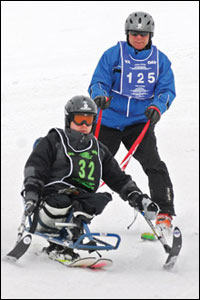The National Disabled Veterans Sports Clinic celebrated its 23rd anniversary event with 370 veteran participants, more than 200 certified adaptive ski instructors, and 461 volunteers at Snowmass Village, Colorado, March 29-April 3. Though the event was set in a skier’s paradise near Aspen, adaptive ski events were just a few of the activities available to veterans and their families. The event was jointly sponsored by the Veterans Administration (VA) and Disabled American Veterans (DAV).
“Recreation therapy is sometimes…minimized among therapies,” said Sandy Trombetta, founder and director of the event, “but recreation is a real need in everyone’s life.” Trombetta, a former recreation therapist, told The O&P EDGE that he founded the event because he had seen in his own veteran clients “what the power of nature and skiing does for [veterans’] minds, bodies, attitudes, spiritual sense, and emotions…. The feeling of freedom is overwhelming. It’s not really about the skiing but about what the skiing does for people [with disabilities] inside. It has a profound effect on their regaining a piece of themselves that they thought was lost forever.”

Joey Bozik (in black)
Joey Bozik, a former military police (MP) officer with the 92nd Airborne, endured a bilateral transfemoral amputation and a right transradial amputation when his Humvee was hit by an improvised explosive device (IED) in 2004. Now a busy new father and college student, Bozik came with his wife to the clinic for the fourth time this year. “The clinic is always great,” he said. “With the number of volunteers and participants who show up and the way that Aspen opens its arms to us…it’s always been a tremendous event. You come away from this week feeling like the cup is full again and you can keep going on for the rest of the year, until it comes around again.”
Bozik, sometimes joined by his wife, has participated in a handful of the activities offered at the clinic, including monoskiing and trap and skeet shooting. Other activities offered include downhill and cross-country adaptive skiing, scuba diving, sled hockey, snowmobiling, rock climbing, fencing, golf, Snow Cat rides, and self-defense training.
“This event catapults people into thinking about themselves so much differently than before,” Trombetta said, “so we created other venues, like shooting sports, snowmobiling, scuba diving, and sled hockey, to captivate people even more and help segue them into living this way once they return home.”
Neal Eckrich, acting chief operating officer for prosthetics for the Veterans Administration (VA), was pivotal in the VA’s 2006 decision to begin providing adaptive recreation devices. He came to the clinic to educate participants, trainers, and volunteers about the many adaptive sports devices that are now available through the VA. Eckrich has found that veterans are “very excited that we’re there to support them.” He explained that the VA’s participation in the clinic is part of the its goal of creating “the healthy veteran.” Chronic illness, he said, “is a much greater cost burden to the taxpayer than it is to keep these guys healthy and active. And that’s not even taking into account the mental health aspects of getting people out and about and being active among their peers.”
Raymond Dempsey, National DAV commander, was also onsite, partly as a participant. He said that Trombetta, the VA, and the DAV work so well together because “we’re here for one reason: to make the veterans feel more human…to show veterans that they’re not ‘disabled,’ but that they just have to do…things a little differently.” He encourages “anybody who can get out here, whether as a volunteer or a participant, just to come out here one day to see the ‘miracle on the mountain.’ You’ll be surprised at what disabled veterans can do.”
-Morgan Stanfield




